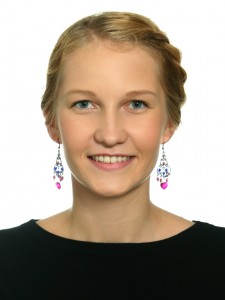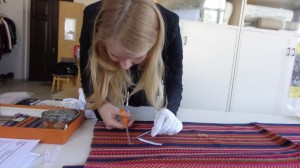 Among the analytical chemistry research directions at UT are studies of materials, especially materials with artistic and/or historic relevance. Textiles have a prominent place among these materials and the leading force of textile analysis in our group is PhD student Pilleriin Peets.
Among the analytical chemistry research directions at UT are studies of materials, especially materials with artistic and/or historic relevance. Textiles have a prominent place among these materials and the leading force of textile analysis in our group is PhD student Pilleriin Peets.
We have the pleasure to announce that her master’s thesis defended in June 2016 “Method development for textile dye analysis on the example of red dyes” was awarded with the 1st prize in the Estonian National Contest for University Students supported by Estonian Research Council. Congratulations, Pilleriin!
This very interesting and challenging master’s thesis involved development of methodologies using complementary techniques – FT-ICR-MS with ESI and MALDI sources, LC-QQQ-MS, SEM-EDS – for thoroughgoing investigation of composition of red dyes.
Natural dyes (extracted from plants and insects) are complex mixtures of sophisticated organic compounds and their chemical composition is still not fully known. Dyes can be divided into different groups (anthraquinones, flavonoids etc) but within a group, they can be quite similar. In order to fix dyes on fabrics mordants (alum, tannic acid etc) are commonly used. Identifying dyes and mordants in textiles is challenging: samples are very small, analyte concentrations are low, objects consist of many components (incl. impurities) and their decomposition products. So, accurate methods that can work with small amounts of sample and very low analyte contents in samples, are still needed.
 During her master’s studies Pilleriin Peets managed to overcome all these difficulties and developed a useful methodology for dye analysis. At first, Pilleriin collected different red dyes (madder, cochineal etc), dyed pure wool pieces and then extracted the dyes from dyed wool. During dyeing, she adjusted different recipes and developed suitable dyeing procedure. After that she analysed all these dye standard solutions and fibre extracts, using HPLC-QQQ-MS, ESI- and MALDI-FT-ICR-MS methods and developed a suitable measurement methodology for every dye. Additionally, different mordants were analysed from known mordanted samples and unknown real samples using SEM-EDS. The developed methodology was applied to real samples from the Estonian National Museum and private collections (photo on the right: Pilleriin taking textile samples at the Estonian National Museum).
During her master’s studies Pilleriin Peets managed to overcome all these difficulties and developed a useful methodology for dye analysis. At first, Pilleriin collected different red dyes (madder, cochineal etc), dyed pure wool pieces and then extracted the dyes from dyed wool. During dyeing, she adjusted different recipes and developed suitable dyeing procedure. After that she analysed all these dye standard solutions and fibre extracts, using HPLC-QQQ-MS, ESI- and MALDI-FT-ICR-MS methods and developed a suitable measurement methodology for every dye. Additionally, different mordants were analysed from known mordanted samples and unknown real samples using SEM-EDS. The developed methodology was applied to real samples from the Estonian National Museum and private collections (photo on the right: Pilleriin taking textile samples at the Estonian National Museum).
These developed methodologies are right now being extended to the analysis of other colours and dyes: Pilleriin continues this investigation during her PhD studies and in the future there will be coming much more interesting research developments in this topic.
Pilleriin started with serious scientific research already in the bachelor’s studies: she developed an approach of classification of single- and two-component textile materials using ATR-FT-IR spectra and chemometric methods, principal component analysis (PCA) and discriminant analysis on the basis of altogether 89 textile samples belonging to 26 different types (11 one- and 15 two-component textiles). This work has been published in Spectrochimica Acta Part A 2017, 173, 175-181.
